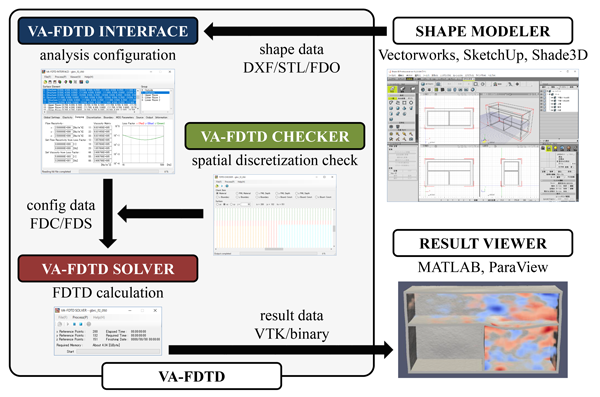NEWS
- 22 MAR 2025VA-FDTD was updated (version 2.0.02). Along with that, DOWNLOAD page was updated. For details, unzip the downloaded file and refer to RELEASE_NOTE.txt.
- 08 MAR 2025VA-FDTD was updated (version 2.0.01) and FORTRAN VA-FDTD SOLVER was updated (version 2.0.00). Along with that, DOWNLOAD pages were updated. For details, unzip the downloaded file and refer to RELEASE_NOTE.txt.
- 19 JAN 2025HOME, DOWNLOAD, TUTORIAL, and FAQ were updated.
- 05 JAN 2025VA-FDTD was updated (version 2.0.00). Along with that, LICENSE and DOWNLOAD pages were updated. For details, unzip the downloaded file and refer to RELEASE_NOTE.txt.
- 25 NOV 2024VA-FDTD was updated (version 1.2.09). Along with that, DOWNLOAD page was updated. For details, unzip the downloaded file and refer to RELEASE_NOTE.txt.
- 06 OCT 2024MATLAB FUNCTION M-FILES were updated (version 1.1.04). Along with that, LICENSE and DOWNLOAD pages were updated. For details, unzip the downloaded file and refer to RELEASE_NOTE.txt.
- 12 SEP 2024VA-FDTD was updated (version 1.2.08). Along with that, DOWNLOAD page was updated. For details, unzip the downloaded file and refer to RELEASE_NOTE.txt.
- 11 AUG 2024VA-FDTD was updated (version 1.2.07). Along with that, DOWNLOAD page was updated. For details, unzip the downloaded file and refer to RELEASE_NOTE.txt.
- 27 JAN 2024MATLAB FUNCTION M-FILES were updated (version 1.1.03). Along with that, LICENSE and DOWNLOAD pages were updated. For details, unzip the downloaded file and refer to RELEASE_NOTE.txt.
- 15 JAN 2024VA-FDTD was updated (version 1.2.06). Along with that, DOWNLOAD page was updated. For details, unzip the downloaded file and refer to RELEASE_NOTE.txt.
- 01 JAN 2024EXAMPLES were updated (version 1.0.02). Along with that, DOWNLOAD page was updated.
- 23 NOV 2023VA-FDTD was updated (version 1.2.05). Along with that, DOWNLOAD page was updated. For details, unzip the downloaded file and refer to RELEASE_NOTE.txt.
- 22 SEP 2023VA-FDTD was updated (version 1.2.04). Along with that, DOWNLOAD page was updated. For details, unzip the downloaded file and refer to RELEASE_NOTE.txt.
- 02 JUL 2023VA-FDTD was updated (version 1.2.03). Along with that, DOWNLOAD page was updated. For details, unzip the downloaded file and refer to RELEASE_NOTE.txt.
- 23 FEB 2023VA-FDTD and EXAMPLES were updated (version 1.2.02 and version 1.0.01, respectively). Along with that, DOWNLOAD page was updated. For details, unzip the downloaded file and refer to RELEASE_NOTE.txt.
- 20 JUN 2020VA-FDTD was updated (version 1.2.01). Along with that, DOWNLOAD page was updated. For details, unzip the downloaded file and refer to RELEASE_NOTE.txt.
- 25 FEB 2022VA-FDTD and FORTRAN VA-FDTD SOLVER were updated (version 1.2.00). Along with that, DOWNLOAD page was updated. For details, unzip the downloaded file and refer to RELEASE_NOTE.txt.
- 18 MAY 2021MATLAB FUNCTION M-FILES were updated (version 1.1.02). Along with that, DOWNLOAD page was updated. For details, unzip the downloaded file and refer to RELEASE_NOTE.txt.
- 28 OCT 2020VA-FDTD was updated (version 1.1.09). Along with that, DOWNLOAD page was updated. For details, unzip the downloaded file and refer to RELEASE_NOTE.txt.
- 06 SEP 2020VA-FDTD and FORTRAN VA-FDTD SOLVER were updated (version 1.1.08 and version 1.1.02, respectively). Along with that, DOWNLOAD page was updated. For details, unzip the downloaded file and refer to RELEASE_NOTE.txt.
- 29 AUG 2020FORTRAN VA-FDTD SOLVER was updated (version 1.1.01). Along with that, DOWNLOAD page was updated. For details, unzip the downloaded file and refer to RELEASE_NOTE.txt.
- 17 JUN 2020VA-FDTD was updated (version 1.1.07). Along with that, DOWNLOAD page was updated. For details, unzip the downloaded file and refer to RELEASE_NOTE.txt.
- 25 AUG 2019VA-FDTD was updated (version 1.1.06). Along with that, DOWNLOAD page was updated. For details, unzip the downloaded file and refer to RELEASE_NOTE.txt.
- 05 AUG 2019MATLAB FUNCTION M-FILES were updated (version 1.1.01). Along with that, DOWNLOAD page was updated. For details, unzip the downloaded file and refer to RELEASE_NOTE.txt.
- 25 APR 2019VA-FDTD was updated (version 1.1.05). Along with that, DOWNLOAD page was updated. For details, unzip the downloaded file and refer to RELEASE_NOTE.txt.
- 17 APR 2019VA-FDTD was updated (version 1.1.04). Along with that, DOWNLOAD page was updated. For details, unzip the downloaded file and refer to RELEASE_NOTE.txt.
- 05 MAR 2019A reference was added to HOME.
- 09 FEB 2019VA-FDTD was updated (version 1.1.03). Along with that, DOWNLOAD page was updated. For details, unzip the downloaded file and refer to RELEASE_NOTE.txt.
- 19 JAN 2019A reference was added to HOME.
- 01 NOV 2018A reference was added to HOME.
- 15 SEP 2018VA-FDTD was updated (version 1.1.02). Along with that, DOWNLOAD page was updated. For details, unzip the downloaded file and refer to RELEASE_NOTE.txt.
- 03 SEP 2018A reference was added to HOME.
- 23 FEB 2018A reference was added to HOME.
- 23 FEB 2018The English version of this web site was proofread. Along with that, ACKNOWLEDGEMENT was added to HOME and all English pages were updated.
- 13 FEB 2018The English versions of VA-FDTD helps were added (version 1.1.01). Along with that, DOWNLOAD and TUTORIAL pages were updated.
- 1 FEB 2018The English version of this web site was launched. VA-FDTD and FORTRAN VA-FDTD SOLVER were majorly updated (version 1.1.00). MATLAB FUNCTION M-FILES was updated (version 1.1.00). Along with those, HOME, DOWNLOAD, TUTORIAL, and FAQ pages were updated. For details, unzip the downloaded files and refer to each RELEASE_NOTE.txt.
- 23 DEC 2015FORTRAN VA-FDTD SOLVER was updated (version 1.0.01). Along with that, DOWNLOAD page was updated. For details, unzip the downloaded file and refer to RELEASE_NOTE.txt.
- 16 DEC 2015VA-FDTD was updated (version 1.0.02). Along with that, DOWNLOAD page was updated. For details, unzip the downloaded file and refer to RELEASE_NOTE.txt.
- 22 OCT 2015The SKETCHUP plugin (version 1.0.00) for exporting a DXF file was released. Along with that, HOME, LICENSE, DOWNLOAD, and TUTORIAL pages were updated.
- 02 OCT 2015VA-FDTD was updated (version 1.0.01). Along with that, DOWNLOAD page was updated. For details, unzip the downloaded file and refer to RELEASE_NOTE.txt.
- 17 SEP 2015This website was introduced at the autumn meeting of the Acoustical Society of Japan.
- 15 SEP 2015This website was opened.

